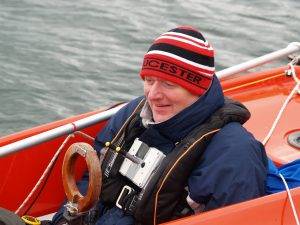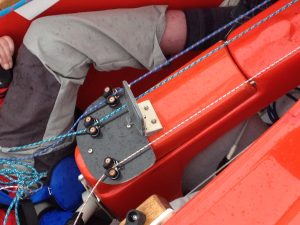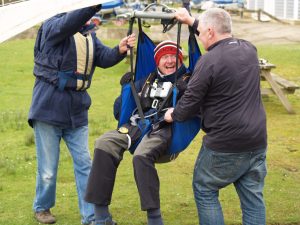There is a variety of equipment available to enable people with even the most profound disabilities to sail independently. It is possible to sail completely independently, and be competitive using blow suck controls to helm (steer) and to control the sails. A Dutch sailor came 2nd in the Hansa European Championships using chin controls for her sails and steering, narrowly losing out to an able-bodied sailor. Everybody’s needs are different, and it takes a bit of time to work out what equipment suits you.

So how do I sail it? On my chest you can see two joysticks; these control the main sheet and jib sheet – in and out using motors. The loop in front of me is for steering. I have limited strength and movement in my arms, so by extending my tiller I have more leverage. Because I have no hand function, I hook my wrist inside the loop and pull the tiller. The seat is fixed in the middle, and have lateral supports either side of my chest to keep me upright. The keel weighs 70kg and has 1m draught; this prevents the boat from capsizing. So that I don’t have to duck, the boom is above head height. It has a self-tacking jib so that only 1 jib sheet is necessary.
 The control lines come to a central console in front of me, on top of the keel. These control the kicking strap, outhaul, and jib tensioner. I use my teeth and arms to change these settings. I can only really do this between races unless the wind is light. The purchase on all of these has been changed to make the necessary effort less. Their are two mirrors on the boat so that I can see what is going on behind me and I know it’s safe to tack, or when other boats are jostling for position and taking my wind.
The control lines come to a central console in front of me, on top of the keel. These control the kicking strap, outhaul, and jib tensioner. I use my teeth and arms to change these settings. I can only really do this between races unless the wind is light. The purchase on all of these has been changed to make the necessary effort less. Their are two mirrors on the boat so that I can see what is going on behind me and I know it’s safe to tack, or when other boats are jostling for position and taking my wind.

Not only do I need a lot of assistance in the boat, I need to be hoisted in and out. Fortunately Whitefriars is equiped with 2 hoists and a stable pontoon. Also there is level access around most of the club house.
Here’s a video clip of me training on Rutland Water.



